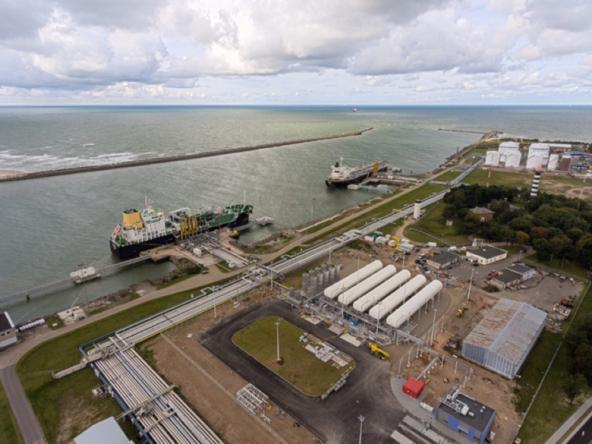HAZOP / SIL / LOPA for LNG Reloading Station
Projectowner:
Klaipėdos Nafta, Lithuania
Timeframe:
2016 – 2017
Key Project Data:
Klaipėdos Nafta (KN), Lithuania’s state-owned petroleum product terminal operator appointed PPS-CF Consortium in 2015 to carry out EPC construction of an LNG Reloading Station in Klaipėda, Lithuania.
The Reloading Station will be used for storage of LNG in vacuum insulated tanks, filling of LNG to road tankers, filling of LNG to ships as fuel (bunkering) and evaporation of LNG to provide natural gas to local gas consumers. LNG is supplied to the station from an LNG carrier.
The facility comprises mainly:
- Five 1000 m³ vacuum insulated tanks
- Unloading / bunkering facility at existing jetty
- Two truck loading bays for filling of LNG-trucks
- New piping, instrumentation, utilities and control and safety system

Scope of Services:
The EPC Consortium engaged PSC to provide risk evaluation services, including:
- HAZOP Workshop at Owner’s premises
- SIL-Analysis / Workshop using calibrated Risk Graph Method
- LOPA of critical SIF functions
- HAZOP and SIL update after design changes
- Preparation of Safety Requirements Specification
All services were carried out in accordance with PSC’s FSM-Plan as per DIN EN 61511 and CFSE-certified.
PSC has provided ongoing risk management consulting services to Klaipėdos Nafta LNG projects since 2013.
Extended Description:
The following gives a detailed description of PSC‘s services.
The HAZOP/SIL Workshop took place over 4 days at Owners office adjacent to the new site. PSC provided HAZOP Chairman and Scribe. 25 persons participated, including representatives of Contractor and Owner. In total 267 entries were made in the HAZOP Record Sheets for 10 nodes, from which 19 deviations were identified to have a residual risk in ALARP region. There were 86 HAZOP recommendations.
The SIL Workshop took place directly following the HAZOP. PSC pre-populated the SIL-worksheets in order to streamline the Workshop. Of 41 potential SIFs, 7 functions did not require a SIL rating, 25 resulted in SIL 1, four SIL 2, and five SIL 3 functions.
Five SIFs identified to have SIL-3 were further evaluated using LOPA methodology as per IEC 61511-3, Annex F. Additional IPL’s, as well as non-ESD control and monitoring functions were considered. Finally the PFD was re-calculated, confirming that a less stringent SIL-rating was permissible for the individual elements of these loops.
Approximately one year after completion of the original HAZOP / SIL anylsis, Contractor requested a re-validation exercise considering changes that had been incorporated during the further detailed design. PSC identified and evaluated 138 changes for impact on HAZOP/SIL Analysis, resulting in 125 changed or new HAZOP causes, with corresponding updates to HAZOP conclusions and recommendations. For the SIL report, the revalidation resulted in two additional SIFs, as well as complete revision of all evaluation sheets (including revised tag numbers, updated HAZOP references and more detailed definition of the SIF action).
PSC prepared the SRS in line with IEC61511 guidelines, including an individual SRS-Sheet for each SIF, as well as relevant data such as: proof test requirements, final element response times, mission time/life cycle requirements, MTTR, MTTFS, HFT, RRF. The SRS was aligned with the SIL-Validation report which was prepared by a separate Consultant.



